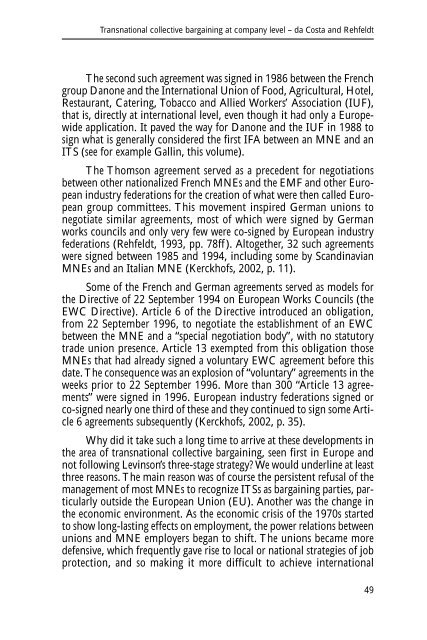CROSS-BORDER SOCIAL DIALOGUE AND AGREEMENTS: An ...
CROSS-BORDER SOCIAL DIALOGUE AND AGREEMENTS: An ...
CROSS-BORDER SOCIAL DIALOGUE AND AGREEMENTS: An ...
Create successful ePaper yourself
Turn your PDF publications into a flip-book with our unique Google optimized e-Paper software.
Transnational collective bargaining at company level – da Costa and Rehfeldt<br />
The second such agreement was signed in 1986 between the French<br />
group Danone and the International Union of Food, Agricultural, Hotel,<br />
Restaurant, Catering, Tobacco and Allied Workers’ Association (IUF),<br />
that is, directly at international level, even though it had only a Europewide<br />
application. It paved the way for Danone and the IUF in 1988 to<br />
sign what is generally considered the first IFA between an MNE and an<br />
ITS (see for example Gallin, this volume).<br />
The Thomson agreement served as a precedent for negotiations<br />
between other nationalized French MNEs and the EMF and other European<br />
industry federations for the creation of what were then called European<br />
group committees. This movement inspired German unions to<br />
negotiate similar agreements, most of which were signed by German<br />
works councils and only very few were co-signed by European industry<br />
federations (Rehfeldt, 1993, pp. 78ff). Altogether, 32 such agreements<br />
were signed between 1985 and 1994, including some by Scandinavian<br />
MNEs and an Italian MNE (Kerckhofs, 2002, p. 11).<br />
Some of the French and German agreements served as models for<br />
the Directive of 22 September 1994 on European Works Councils (the<br />
EWC Directive). Article 6 of the Directive introduced an obligation,<br />
from 22 September 1996, to negotiate the establishment of an EWC<br />
between the MNE and a “special negotiation body”, with no statutory<br />
trade union presence. Article 13 exempted from this obligation those<br />
MNEs that had already signed a voluntary EWC agreement before this<br />
date. The consequence was an explosion of “voluntary” agreements in the<br />
weeks prior to 22 September 1996. More than 300 “Article 13 agreements”<br />
were signed in 1996. European industry federations signed or<br />
co-signed nearly one third of these and they continued to sign some Article<br />
6 agreements subsequently (Kerckhofs, 2002, p. 35).<br />
Why did it take such a long time to arrive at these developments in<br />
the area of transnational collective bargaining, seen first in Europe and<br />
not following Levinson’s three-stage strategy? We would underline at least<br />
three reasons. The main reason was of course the persistent refusal of the<br />
management of most MNEs to recognize ITSs as bargaining parties, particularly<br />
outside the European Union (EU). <strong>An</strong>other was the change in<br />
the economic environment. As the economic crisis of the 1970s started<br />
to show long-lasting effects on employment, the power relations between<br />
unions and MNE employers began to shift. The unions became more<br />
defensive, which frequently gave rise to local or national strategies of job<br />
protection, and so making it more difficult to achieve international<br />
49
















